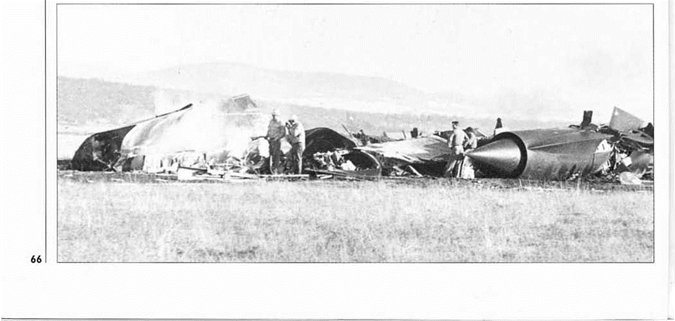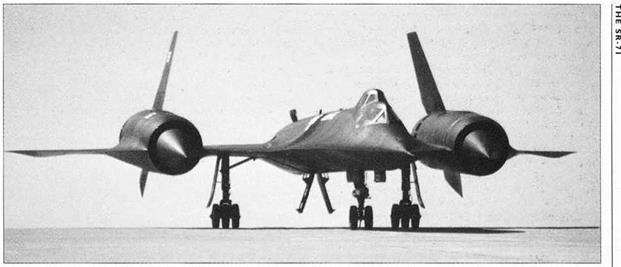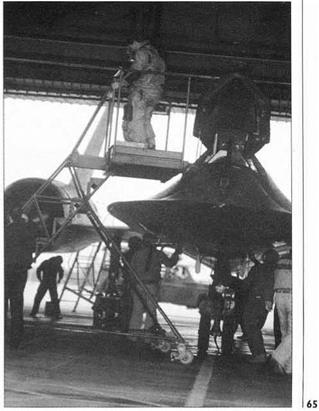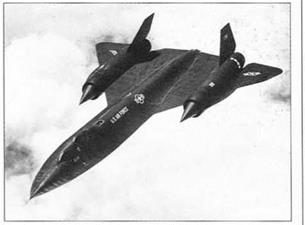Preparations for Deployment
As the 9th SRW prepared to deploy overseas, much talk in the crew lounge was devoted to anti-SAM tactics. The plan was to penetrate enemy airspace at Mach 3; if fired upon, the pilot would accelerate to Mach 3.2 and climb, thereby forcing the missile’s guidance system to recalculate the intercept equation. One half-baked idea was to dump fuel at the same time, thereby becoming lighter and increasing the rate of climb. The debate was ended during a training sortie over Montana, when a crew dumped fuel for ten seconds to see if the afterburner would ignite the fuel trail. Instead it turned instantly into an ice cloud in the -55 degree stratosphere and left a five mile-long contrail – finger pointing directly to the aircraft. The pilot reported that he could see the trail for hundreds of miles after having turned back towards the west!
On 11 January 1968, during this work-up period, yet another incident befell the 9th SRW. Lt Col ‘Gray’ Sowers and ‘student’ Capt Dave Fuehauf – on his third training sortie – experienced a double generator failure in SR-71B ‘957, near Spokane, Washington. They immediately switched off all non-essential electrically powered equipment to conserve batten’ power and despite repeated attempts they were unable to re-set both generators. With most of Washington State bases w eathered out, they had little option but to press on for Beale. Their long straight in approach looked good until the 175kts ‘final’ placed the aircraft in its natural ten degrees nose-up angle of attack. This allowed some dry-tank fuel inlet ports to ‘suck air’ which in turn interrupted the gravity How of fuel to the engine combustion chambers, because the fuel boost pumps were inoperative. This caused cavitation, both J58s flamed out and at 3,000ft Gray ordered bailout. Both crew members survived as ‘957 ‘pancaked’ inverted, only seven miles north of Beale’s long runway.
Above On landing, a forty-foot diameter brake chute rapidly decelerates the aircraft. (Paul Crickmore)
Below Back in ‘the barn’ the crew disembark and are driven back to the Physiological Support Division (PSD) building where they shower and change before debriefing the mission.
(Paul Crickmore)
|
|
![]() OL-8
OL-8
As the 1 SRS neared operational readiness, decisions were made by Col Bill Hayes (9th SRVV Commander) and Col Hal Confer (Director of Operations) as to which crews would be first to be deployed to Kadena AB, Okinawa. Three aircraft and four crews would be deployed and the crews themselves pulled straws to decide the ‘batting order’; the fourth crew would be standby for the three deploying aircraft and would arrive on Kadena, if their services weren’t needed, by KC-135Q tanker. Command of the Operating Location (OL-8) would alternate between the 9th SRW’s wing commander and vice commander (and later Deputy Chief of Operations). Two days before Glowing Heat, the codename for the deployment, six KC-135Q. tankers were positioned at I lickam AFB, Hawaii. Emergency radio coverage was set up on Wake Island and on 8th March 1968, Majs Buddy Brown and his RSO Dave Jenson left Beale in ‘978 and became the first Senior Crown crew’ to deploy to Kadena. Two
days later Maj Jerry’ O’Malley and Capt Ed Payne delivered ‘976 to the OL, to be follow’ed on the 13 March by Bob Spencer and Keith Branham in ‘974. Finally, three days later, in late evening rain Jim Watkins and Dave Dempster the back-up crew, were wearily disgorged from the ‘135. The crews and their mounts were ready for business.
Due to maintenance problems, Buddy Brown and Dave Jenson missed their chance of being the first crew to fly the SR-71 operationally; instead, that accolade went to Maj Jerry O’Malley and Capt Ed Payne in ‘976. The
Below Two SR-71В pilot trainers were built, serials 17956 and 17957. (USAF)

Bottom SR-7 IB. 17957 crashed on I I January 1968, both the IP Lt Col ‘Gray’ Sowers and the student Capt Dave Fruehauf ejected safely. (Appeal Democrat)

mission was flown on Thursday 21 March 1968 and their route Was similar to that flown by Mele Vojvodich in his A-12 ten months earlier. However, with its large, high definition camera in the bay, the A-12 was a photographic platform only. For its first operational mission, the SR-71 carried both cameras and Goodyear SideLooking Airborne Radar (SLAR) located in a detachable nose section, together with its associated AR-1700 radar recorder unit.
Having refuelled after their first run, Jerry’ climbed and accelerated on track for their final ‘take’ for the mission, which was to be flown over the DMZ. For this run, the primary sensor was the SLAR. On arrival back at Kadena Jerry and Ed were confronted with a base completely ‘fogged in’. Despite a good Ground Controlled Approach (GCA), Jerry never saw the runway and climbed back to contemplate further options. Low on fuel, another tanker was launched and 25,0001bs of fuel taken onboard. The crew then received a two-figure encoded number which told them to divert to Taiwan. In company with two • tankers and the SR-71 adopting a tanker call-sign for security reasons, the three ship formation made its slow, lumbering way to Ching Chuan Kang, Taiwan. On arrival the SR-71 was quickly hangared and the next day the ‘take’ was downloaded and despatched for processing – the film to the 67th RTS at Yokota AB, Japan and the SLAR imagery to the 9RTS at Beale AFB. After two nights at CCK, Jerry and Ed ferried ‘976 back to Kadena and a superb reception from their friends.
Post-mission intelligence results were stunning. The SLAR imagery had revealed the location of many artillery emplacements around Khe Sanh, and a huge truck park used for logistics support. These sites had eluded US sensors on other recce aircraft up to that point. Over the next few days air strikes were mounted against both targets, reducing their effectiveness dramatically. After a 77 day siege, Khe Sanh was at last relieved on 7 April 1968 (two weeks after ‘976’s discovery sortie). As a result of their highly successful mission both Maj Jerome F O’Malley and Capt Edward D Payne were each awarded the Distinguished Flying Cross. On its very’ first operational mission the SR-71 had proved its value.
Above The raised cockpit of SR-71В 17956 is immediately apparent as this aircraft taxies back – note brake chute doors open. (Paul Crickmore)
Mow To compensate for the loss of I7957.YF-I2A 60-6934 was taken from storage and its front forebody replaced by a static test specimen to create the so-called SR-71C, which was re-serialed 17981 and nicknamed The Bastard’. (USAF)
|
|
Early OL-8 operational sorties were typified by problems involving the SR-71’s generators, this often led to aircraft having to divert into one of the USAF bases in Thailand. Of the 168 SR-71 sorties flown by OL-8 throughout 1968, 67 were operational missions over North Vietnam, the remaining sorties being FCFs or for crew training. In addition the first of many aircraft change arounds took place when over a period of seven days in September, ‘970 and ‘962 took over from ‘978, ‘976 and ‘974. Crew rotation also took place with no less than 21 crews having taken the SR-71 into battle over the same period. It was while operating out of Kadena that the SR-71 received its nickname, Habu,
![]() after a poisonous pit viper found on the Ryuku Islands: though non aggressive, it can inflict a painful bite if provoked. Although resisted by officialdom, the name Habu proved to be ineradicable amongst all associated with Senior Crown.
after a poisonous pit viper found on the Ryuku Islands: though non aggressive, it can inflict a painful bite if provoked. Although resisted by officialdom, the name Habu proved to be ineradicable amongst all associated with Senior Crown.
OL-8 lost its first ‘Habu’ on 10 May 1970, shortly after Majs Willie Lawson and Gil Mortinez had air refuelled ‘969 near Korat RTAFB. Struggling to clear a saddle-back of cloud at 30,000ft, Lawson eased ‘969 into a slightly steeper climb. However, on entering turbulent cloud, both engines flamed out. The aircraft’s angle of attack increased, then suddenly the nose pitched-up and recovery was impossible. Both crew members ejected safely and landed, resplendent in their ‘silver moon suits’, near U Tapao.












